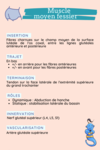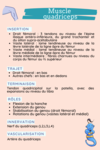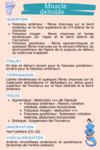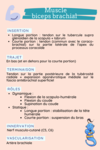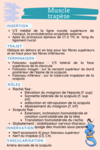
Basketball was first introduced in the United States and Canada by a physical education teacher in 1891. Basketball is a sport that relies on many changes of direction by the players, in other words, it is a pivot sport. These numerous changes can be a factor of numerous injuries: tears, sprains, etc. For preventive follow-up, osteopathy will reduce the risk of injury and for post-traumatic follow-up, osteopathy will reduce the risk of recurrence.
Which muscles are used in basketball?
The many movements of the game such as shooting, dunking, jumping or dribbling require more muscles than during a simple passive game. Let's break down all of these muscles:
Lower limb muscles
- The leg ischiae : they are responsible for the extension of the thigh and the flexion of the leg
- Calf muscles: sural triceps, twins, soleus for the extension of the foot on the leg
- The quadriceps: they ensure leg extension and thigh flexion
- The glutes: they are responsible for the mobility of the thigh and stabilize the pelvis
Trunk muscles
- The abdominals
- The pectorals
Upper limb muscles
- The elevator of the scapula
- The deltoid
- The rotator cuff (subscapularis, infraspinatus, lesser ring and supraspinatus)
- The biceps and triceps
- The trapeze
- The large serrated
What are the common injuries in basketball?

Lower extremity injuries
Ankle sprain
Ankle sprains most often occur during rollovers, jump landings or changes in direction. However, it can also occur during quick starts or attempts to get off the ground.
For a sprained ankle, here is the recommended treatment:
- Depending on the severity of the sprain, it takes between 3 to 8 weeks to heal.
- Do not take anti-inflammatory drugs.
- You can ice for 12 minutes at the time to reduce the bleeding, but it is not necessary to ice the following days.
- Strapping can be beneficial.
- Physical therapy: muscle strengthening exercises for the fibular muscles and proprioception exercises can be performed.
- Osteopathy: thanks to painless manipulations, the osteopath will be able to evaluate the severity of the injury. He will then be able to treat the injury as a whole to restore the necessary joint mobility. The osteopath will also assess and correct the consequences on the rest of the body. If your osteopath is trained, he will be able to apply strapping or kinesiotaping to keep the ankle in line and optimize recovery.
Fissure of the short fibular tendon
The pain that corresponds to the tear of the tendon appears progressively when walking or during sports, it is located behind and outside the ankle.
Dislocation of the fibular tendons
The fibular tendons are located behind the lateral malleolus. Their dislocation can be recognized by a swelling and a sensation of movement of the tendons under the skin. In some cases, the patient can feel subluxation movements of the tendons that correspond to snapping.
Fracture of the fifth metatarsal (MV)
The factors are similar to those of ankle sprains, and it is possible to have an ankle sprain at the same time!
The symptoms are:
- A swelling
- In some cases hematoma/ecchymosis
- A pain localized at the level of the fracture generally at the base of the 5th metatarsal, reproduced to palpation, to compression and distraction of this metatarsal and to percussion.
The diagnosis is usually confirmed with an x-ray. The treatment of this injury is based on wearing a cast or a walking boot for approximately 6 weeks. Complete healing is the necessary criterion for resuming basketball.
Achilles tendinopathy
Repeated jumping, overly intensive muscle strengthening or overly intense recovery can cause this injury.
The symptoms are:
- Pain in the lower part of the calf and the back of the heel.
- Thickening of the tendon on palpation, especially in chronic tendinopathies, and sometimes even nodules
With this diagnosis, it is advisable to make an osteopathic and possibly podological assessment to determine the cause of this tendon suffering.
Rupture of the Achilles tendon
This rupture of the Achilles tendon can be partial or total. This injury requires the complete cessation of sport and very good physiotherapy treatment in order to limit the after-effects as much as possible.
Knee pathologies
- Rupture of the anterior cruciate ligament (during a sudden stop or an impulse with a change of position)
- Instability of the patella (it does not engage properly, which can cause dislocations, usually external)
- Patellofemoral syndrome: the player may experience muscle stiffness, ligament laxity, and poor motor control. Treatment will be based on strengthening the vastus medialis and gluteus medius.
- Tendonitis or inflammation of the patellar or quadricipital tendons (due to repetitive jumping, intensive muscle strengthening). This is known as " jumper knee " syndrome.
Complementary examinations are to be carried out (X-ray/ MRI/ ultrasound). For knee pathologies, the patient will have a pseudo-instability of the knee, snapping, acute pain, a sensation of blocking.
Plantar fasciitis and plantar fascia rupture
The plantar fascia is a membrane under the foot that extends from the beginning of the toes to the foot. It can become inflamed if overused or improperly stressed, and then it can remodel and be a source of significant pain. It can also tear or rupture.
Upper extremity injuries
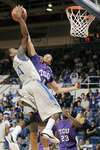
The shoulder
The main pathologies of the upper limb found in basketball at the level of the shoulder are traumas:
- Bruises
- Fracture of the clavicle
- Disjunction of the acromioclavicular joint (sprain)
- Shoulder dislocation
Some shoulders can also be unstable and painful:
- Tendinopathies, pathologies of the rotator cuff
- Lesion of the glenohumeral rim
The elbow
In the vast majority of cases, it is a dislocation, a tendonitis or a fracture:
- Elbow dislocation: the elbow is put back in place in the hospital after a neurological assessment and an X-ray. In the most serious cases, the treatment can be surgical. It takes about 3 weeks of immobilization. The resumption of sport can be considered after about 6 weeks of rest. It is possible to resume an adapted physical activity.
- Tendinopathy: the two tendinitises of the elbow are the golf elbow located on the inside of the elbow and the tennis elbow located on the outside of the elbow. This injury is related to poor muscular solicitation or too great a training load. For treatment, the player must reduce training loads and do muscle strengthening in this area. If the tendonitis is persistent, surgery may be considered.
- Fracture: There are two places where elbow fractures can occur, at the proximal end of the radius or ulna, but also at the olecranon. In some cases, surgery is necessary followed by immobilization, in other cases, a simple immobilization will suffice. It takes about three weeks of immobilization before starting rehabilitation.
The wrist
In the majority of cases, it is fall receptions or bad ball receptions that are the cause of these traumas, we find :
- Fracture of the scaphoid: complicated to detect because it can appear up to 10 days after the trauma. It is therefore necessary in some cases, to redo examinations a few days later. Immobilization is essential and should not be taken lightly to reduce the risk of complications.
- Wrist sprain: an immobilization is sufficient, its duration varies according to the case but can be between 2 to 6 weeks.
The hand
Fractures, sprains and dislocations are on the podium of hand injuries.
- Fracture: immobilization for at least 6 weeks, surgery may be considered.
- Simple dislocation: count on immobilization for 2 to 3 days then protection during physical activity
- Unstable dislocation: wear a bandage or strapping for 3 to 6 weeks and then protect it during sports activities for several weeks.
How to prevent basketball injuries?
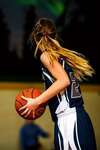
Proprioception
Proprioception is the brain's perception of different body postures and positions. If your proprioception is advanced, your brain will have the reflex to compensate for difficulties or imbalances by putting in place protective mechanisms. This reduces the risk of injury.
For basketball players, the lower and upper limbs must gain in proprioception to prevent injuries but also to gain in agility. The proprioception of the upper limbs must not be neglected in basketball players.
Joint flexibility
A good articular amplitude is necessary to ensure a good explosiveness during the game. To do this, we can make joint relaxations, stretching away from training to be cold.
Muscular strengthening
Performance itself is based on muscle strengthening. It improves speed, strength, explosiveness, and is an essential tool for injury prevention.
Eccentric muscle work has a lot to do with prevention but also with reathletization.
Osteopathy

Osteopathy will allow, with the help of painless manipulations, to prevent and/or treat imbalances in the human body. The osteopath will be able to analyze the body in its entirety and identify possible imbalances and treat them.
After an injury, the osteopath will act in multidisciplinary with other practitioners such as the physiotherapist or the physical trainer. The training of your osteopath allows him to treat you with joint, muscle and facial manipulation techniques. If your osteopath is trained, he will be able to apply strapping or kinesiotaping bands to optimize your recovery.
Marie Messager
Osteopath D.O
2 rue Alexis de Tocqueville
78000 Versailles
